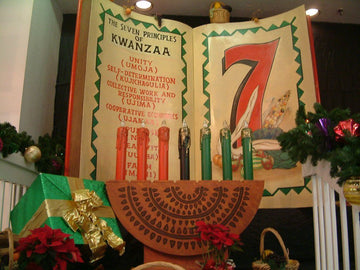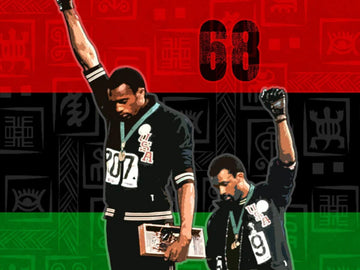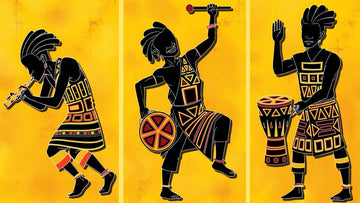
The party season is just around the corner!! ️🎉️🎉 In December, there are numerous festivals to enjoy. It's almost that time of year when everyone starts thinking about Christmas🎅🏾. But don't forget about another major African-rooted holiday: Kwanzaa.
Kwanzaa is a one-of-a-kind festival that reminds African-Americans and pan-Africans of their traditional culture. You may have considered this event as a typical black holiday, but not everyone appreciates the true significance of this celebration.
This festival not only reminds blacks of their ancestry and roots, but also symbolizes the African American community's distinct goals, ambitions, and traditions. It is an incentive to reflect on that culture and to continue to build on it by deliberate life.
To assist you in having a genuinely meaningful week with friends and family, we've compiled a list of preparatory tips that will make your Kwanzaa even more exciting this year 💃🏾🕺🏾
Table of Contents
- Origins of Kwanzaa
- The Raise and Innovation of Kwanzaa
- How Kwanzaa Is Honored Today
- 7 Steps to Celebrate 2021 Kwanzaa Party with Your Beloveds
- Fill Your Home with The Soul of Kwanzaa
- Refurbish Your Room with Kwanzaa Decorations
- Practice The Kwanzaa Greetings
- Light Kinara (Kwanzaa Candle) Daily.
- Kwanzaa Rituals Can Be Celebrated in a Variety of Ways
- On New Year's Eve (Sixth Day), Hold the Feast (Kwanzaa Karamu)
- Distribute Kuumba's presents.
- Wish You a Blissful Kwanzaa!
Origins of Kwanzaa
Contrary to popular belief about the long and deep roots of this festival, Kwanzaa was founded in 1966. The founder of this festival is Professor Maulana Karenga, chairman of Black studies at California State University, who devoted his life to finding ways to maintain the traditional identities of Afro culture under the strong assimilation of American culture.
Kwanzaa was created during the tumultuous times of 1960s Los Angeles, following the Watts riots of 1965. In 1965, rough treatment by a young African-American man on suspicion of drunk driving led to an outbreak of violence. Karenga called Kwanzaa’s creation an act of cultural discovery, which simply means that he wants to direct African Americans to greater knowledge of their African heritage and past.
Kwanzaa's meaning is inspired by the African tradition of celebrating the very first crop, and its word originates from the Swahili word "matunda ya kwanza" which implies "first fruit" of the yield. Although the East African nations were not involved in the transatlantic slave trade, Karenga's decision to use a Swahili term to name the celebration was symbolic of the pervasiveness of ethnocentrism.
Rooted in the struggles and interests of the civil power and black power movements of the 1950s and 1960s, this festival was a way to define a unique black American identity. For black civil rights movements, the establishment of Kwanzaa can be considered just as fundamental as the Civil Rights Act of 1964. Kwanzaa is their answer to their suffering from the prevalence of white cultural practices that radically oppress them like Jim Crow law.
As a result, a week-long cultural festival honoring family, friends, and Afro ancestry was formed. Kwanzaa, despite its modern years, is celebrated by millions of Black Americans in the United States from December 26 to January 1.
The Raise and Innovation of Kwanzaa
Kwanzaa is not associated with any significant faith like Christmas, Ramadan, or Hanukkah. It is recognized for the deepest values of a community and society that are conveyed through its ritual. Kwanzaa is now widely appreciated in the United States. On the other hand, this ritual is also widely accepted in Canada, the Caribbean, and other parts of the African immigrant community.
Although Kwanzaa was created to give Blacks an alternative to the current holiday and allow blacks to honor themselves and their history, rather than just imitating the customs of the dominant society, this holiday quarreled for recognition in its early years.
Although it was adopted by some urban populations, many Christians and Muslims saw the secular celebration as incompatible with their beliefs. The introduction of Kwanzaa coincided with the disintegration of the Us Organization, which included Karenga's 1971 trial and incarceration for torturing two women he suspected of attempting to poison him.
Nonetheless, Kwanzaa continued to grow by word of mouth, and the holiday became renowned as a celebration of Black family life as a result. Kwanzaa made a mark on mainstream Black culture in the late 1970s and early 1980s thanks to its support from some influential journals. In a December 1976 issue of Jet, actor Roger Mosley defined Kwanzaa as a replacement to a commercialized Christmas as he claimed that “this event is more in line with the direction I want my children to go.”

Rashida s. mar b. from Baltimore, USA, CC BY-SA 2.0, via Wikimedia Commons
Kwanzaa gained popularity in the 1980s and 1990s. Instead of replacing Christmas, the majority began to recognize Kwanzaa as a way to boost their festive season. In 1983, an found that most African-Americans show appreciation and connection to their roots through the way they organize Kwanzaa. Besides the traditions of celebrating Christmas and other activities, the adoption of other ceremonial activities by Kwanzaa is seen as an interesting and meaningful cultural reception.
that: “At a time when we are seeking ways to revitalize our neighborhoods and empower those who have been powerless for too long, Kwanzaa encourages us to rebuild and celebrate the strengths of the African American community. " In 1997, the U.S. Postal Service issued its first Kwanzaa stamp.
How Kwanzaa Is Honored Today
By the 2010s, however, statistics point out that fewer and fewer Black families consider organizing Kwanzaa celebration. There are many reasons given for the refusal to perform this ritual. The first is that this is not a national holiday, so students and working people are often not allowed to take this long holiday.
Besides, the widespread access to the Internet by young black people has sparked many conflicts and controversies surrounding the origin of this holiday. Many people still view Kwanzaa as a “made-up holiday” because of its fresh and bizarre history, and because of the heterogeneity and spontaneity of the way, it is prepared, making this festival increasingly trivial.
In recent years, despite the strong return of the black movement, the number of people organizing this festival has drastically dropped. USA Today reported that in 2019, merely who were on winter holiday said that they would celebrate Kwanzaa.
However, in 2020—after another period of racial unrest over the killings of George Floyd, Ahmaud Arbery, Breonna Taylor as well as the rise of the Black Lives Matter movement, sense of origins and traditional festivals is growing. tend to come back strongly. No matter how many people celebrate this festival, Kwanzaa has become a part of American history and always will be.
The organization of Kwanzaa is not mandatory and rigid, but the festival is a rare occasion for the black descendants to remember the original values of Africa as well as the history of the struggle of African Americans.
7 Steps to Celebrate 2021 Kwanzaa Party with Your Beloveds
Fill Your Home with The Soul of Kwanzaa
Although there are many different ways of celebrating Kwanzaa varies from separating areas, in general, the celebration of Kwanzaa still requires the performer to prepare the following symbols:
- To begin, cover the entire apartment with Kwanzaa decorations. The green cloth is draped over a round table, and a mattress (Mkeka) is stacked on top. Mkeka is a straw or braided mat that had already traditionally served as the cornerstone of African heritage. Everything else is added on top of it.
- Mazao — a bowl filled with fruits, veggies, and grains, these products represent the African crop ceremony as the recompense of production and collaborative effort. Mazao is a reference to African harvest festivities and the fruits of the community's communal effort.

Srinayan, CC BY 3.0, via Wikimedia Commons
- Next, in the most solemn position of the table will be a candle holder (Kinara) carrying the seven candles (Mishumaa Saba). This is the most famous symbol of Kwanzaa.
The seven candles represent the seven principles of the Kwanzaa or the Nguzo Saba ritual, which are derived from the meanings of the ancient African festival. However, the color and meaning of the Kwanzaa candles have been modified to fit African American history and represent the ideals of this community.
The three red candles represent the civil rights movement with struggles, losses, and sacrifices. The three green candles represent hope for the future generations. The single black candle in the center symbolizes the unity of the African diaspora around the world.
- Muhindi — corn ears. Every ear of corn presents for each youngster in your family. If you don't have any children, place two ears to celebrate all the children of the black community. Muhindi is a celebration of prosperity and the continuation of generations in the ancestral land.
- The unity cup (Kikombe papa Umoja) is also commonly found during Kwanzaa. Kikombe cha Umoja is a cup that symbolizes family and community harmony. The basis, ideas, and practices of the Afro community were also employed in the creation of this cup.
- Zawadi (Gift): symbolizes the parents' work and devotion. These kinds of stuff commit the promises that parents make to their children as well. These presents will be distributed on the final day of Kwanzaa.

Photo by Askar Abayev from Pexels
Refurbish Your Room with Kwanzaa Decorations
Decorate the space with Kwanzaa flags, known as Bendera, and posters stressing the seven principles to celebrate the spirit of Kwanzaa. Consider making these flags with your children. It seems thrilling spending time with your toddlers.
The Kwanzaa flag is black, red, and green in hue. Marcus Garvey first defined these colors as the colors of liberation and solidarity. Similar to the Kwanzaa candle meaning, black represents people, red represents their struggles, and green represents the future and hope of their struggle. This is the hue of the African flag as well. In addition to the Bendera, if you or your kids love making flags, consider making African national or tribal flags.
Practice The Kwanzaa Greetings
In Kwanzaa, greeting is a fascinating ritual. Beginning on December 26, greet everyone with "Habari Gani," a customary Swahili salutation that means "what's the news?"
If someone greets you, answer with the following rule (Nguzo Saba) on a routine basis:
- December 26: "Umoja" which means Unity.
- December 27: "Kujichagulia" which means Self-determination.
- December 28: "Ujima" which means Collective work and responsibility.
- December 29: "Ujamaa" which means Cooperative economics.
- December 30: "Nia" which means Purpose.
- December 31: "Kuumba" which means Creativity.
- And the last day on January 1: "Imani" which means Faith.
Non-Afro people are also invited to join in the greetings. "Joyous Kwanzaa" is indeed the customary greeting for them.
Light Kinara (Kwanzaa Candle) Daily.
Following the 7 principles and meanings of Kwanzaa, candles with different meanings will have a corresponding order of lighting. Each day of Kwanzaa week you will have to light new candles in the prescribed order. The black candle will always be lit first. Then the red and green candles will be lit from the outside in turn, a red candle should be mixed with a green candle respectively.
However, there are also some regions where it is customary to light candles from red to green in turn.
Kwanzaa Rituals Can Be Celebrated in a Variety of Ways
Select some of the following activities to do throughout Kwanzaa week, reserving the banquet for the sixth day. Kwanzaa celebrations may include:
- Play traditional Kwanzaa music with drums.
- Reread the African Pledge and the Principles of Blackness together and engage in memorization and discussion.
- Revisit the chapters of African history and the memories of the black civil rights movement and reflect on traditional values and hopes for the future.
- Enjoy the Kinara's candle-lighting ceremony.

Rashida s. mar b. from Baltimore, USA, CC BY-SA 2.0, via Wikimedia Commons
- Performing arts such as dancing, performing arts, or organizing storytelling sessions, carnivals, etc.

Photo by RODNAE Productions from Pexels
On New Year's Eve (Sixth Day), Hold the Feast (Kwanzaa Karamu)
The Kwanzaa feast is a once-in-a-lifetime opportunity for everyone to reconnect with their African heritage. It is typically celebrated on December 31st and is a collaborative and communal endeavor.
Decorate the location of the feast with a red, green, and black color scheme. The room where the feast will be hosted should be dominated by a big Kwanzaa setting. A big Mkeka should be put in the center of the floor, with the food attractively displayed and easily accessible to everybody.
An educational and engaging program should be provided both before and during the feast. The performance should conventionally include greeting, remembrance, reappraisal, strong commitment, and joy, followed by a goodbye speech and a call for greater togetherness.
Beverages are to be distributed from a communal cup, the Kikombe cha Umoja, which is handed around to all festivities during the meal.
Distribute Kuumba's presents.
Finally, presents (Zawadi) are placed on the table. Kuumba, which means "creativity," is strongly encouraged and provides a sense of accomplishment.
The presents are typically exchanged between parents and children and are customarily distributed on January 1st, the last day of Kwanzaa. The gifts are a commitment of love from parents to their children and also of protection, knowledge, and hope to be given to future generations.

Family Wrapping Gift Photo by Askar Abayev from Pexels
Because the giving of presents is so closely associated with Kuumba, the gifts should be educational or artistic in nature. These are often designated for children and are either handcrafted or have some cultural value, such as a history book or heritage emblem.
Let’s rock your Kwanzaa👏🏾👏🏾👏🏾!!!
Wish You a Blissful Kwanzaa!
Last but not least, the ultimate activity for Kwanzaa night is: Spend your precious time wisely. Every family honors Kwanzaa in their own distinctive manner, so spend the family vacation and commemorate your African ancestry in any way you wish to.
Keep in mind, all festivals are celebrated so that we can enjoy time off with our family and treasure the original values of our roots.
2021 is a turbulent and messy year, but just like the green Kwanzaa candles’ meaning, we will always see hope even in the darkest place.




